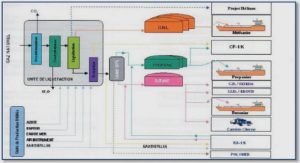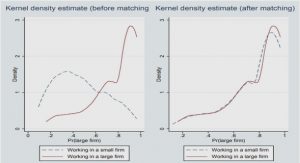Get Complete Project Material File(s) Now! »
Seminal bacteria
The prevalence of bacteriospermia amongst patients seeking ART ranges between 54.0% and 57.0% (Cottell et al., 2000; Gdoura et al., 2008; Kiessling et al., 2008). The occurrence of seminal bacteria could be due to urogenital tract infections, or due to contamination of ejaculated semen samples (Bielanski, 2007). During ART, the female reproductive tract’s immunological defences are circumvented by the direct transfer of gametes or embryos into the uterus (Cottell et al., 1997; Krissi et al., 2004). Bacteria may therefore be inoculated into the uterus, or the in vitro culturing system, resulting in a potential negative impact on the outcome of ART due to poor quality embryos, or failed fertilization (Huyser et al., 1991; Cottell et al., 1997; Cottell et al., 2000; Kastrop et al., 2007). Uterine infections post-IUI have been reported to be 0.01% (Broder, Sims & Rothman, 2007) and infections of embryo culture media, ranges between 0.4% and 6.7% (Cottell et al., 1996; Kastrop et al., 2007). Microbial infections of the culture system during intra-cytoplasmic sperm injection cycles appear to be limited, suggesting that most of the infections in embryo culture systems are due to bacteria being introduced into the culture system by contaminated sperm used for in vitro fertilization (IVF) (Kastrop et al., 2007). Seminal bacteria are inducers of oxidative stress by the generation of reactive oxygen species (Fraczek et al., 2007) and producers of toxins during metabolic processes (Moretti et al., 2009). Incubation of bacteria with sperm in vitro may immobilize sperm cells by adhesion and/or agglutination, may cause apoptosis and can impair sperm-oocyte interaction (Keck et al., 1998; Villegas et al., 2005).
Patients with positive pathogenic micro-organism semen cultures should receive antibiotic treatment to clear the infection prior to ART. However, the treatment of patients with antibiotics will be unsuccessful in the removal of seminal skin contaminants. Huyser & co-workers (1991) reported that semen washing with an extra swim-up step, was superior in the elimination of seminal bacteria when compared to the treatment of patients with antibiotics. Effective semen processing procedures for the elimination of seminal bacteria prior to ART are therefore required, and are discussed in Chapter 3 and the effectiveness reported on in Chapter 6. Bacteria that are relevant to ART will be discussed in the following section, in the order of size and complexity as described by Elder & co-workers (2004).
Viral validation of processed sperm samples
Therapeutic ART should not be performed unless the absence of HIV from the processed sperm sample is confirmed by reliable molecular methods of virus detection (Kato et al., 2006; Garrido & Meseguer, 2006). Methods employed for the detection of HIV-1 in semen and sperm samples are based on the amplification of unique sequences of viral nucleic acids (Meseguer et al., 2002). Available methods for the quantitative evaluation of HIV-1 viral load include reverse transcription polymerase chain reaction (RT-PCR), branched DNA (b-DNA), and nucleic acid sequence-based amplification (NASBA) (O’Shea et al., 2000; Chan & McNally, 2008).
Reverse transcription PCR is the most commonly used molecular method to test for HIV-1 in semen samples. Variations of the method include, i) Multiplex PCR, allowing the simultaneous detection of two or more viruses (Canto et al., 2006), ii) nested-PCR, where two successive amplification reactions can increase sensitivity and specificity (Garrido et al., 2004a), and iii) real-time PCR, whereby the simultaneous amplification and detection of viral DNA result in reduced cost and time of the assay (Espy et al., 2006; Pasquier et al., 2006). Reverse transcription polymerase chain reaction is a sensitive method for the quantitative detection of HIV in blood plasma (Schutten et al., 2000; Gibellini et al., 2004). However, polymerase inhibitors found in seminal plasma may impede the chain reaction during analyses of semen samples (Dyer et al., 1996), potentially resulting in false negatives, under-quantification or inconclusive results (Garrido et al., 2004b). The effect of inhibitors can be reduced by the processing of semen samples (i.e. the removal of seminal plasma) as well as by the analyses of internal or amplification controls (Espy et al., 2006; Garrido & Meseguer, 2006; Chan & McNally, 2008). Nested-PCR has a lower, lowest limit of detection (LLD), when compared to conventional RT-PCR. Garrido & Messeguer (2006) are of the opinion that the method can be utilized to detect a single viral copy/ml. False negatives obtained by RT-PCR could, therefore, be prevented by using nested-PCR (Meseguer et al., 2002). Nested-PCR is, however, time consuming, costly (Dowell et al., 2001) and not commercially available.
Nucleic acid sequence-based amplification may be less susceptible to inhibition and can be utilized reliably for the detection of seminal HIV-1 (Dyer et al., 1996). However, false negatives have been obtained for African patients infected with non-B subtypes of HIV (O’Shea et al., 2000). The b-DNA assay has been reported to be a specific, sensitive and reproducible method for the quantitative evaluation of HIV-1 RNA in low volumes (100 to 250 µl) of blood plasma, yielding results similar to quantitative PCR (O’Shea et al., 2000; Pachl et al., 1995; Cao et al., 1995; Tsongalis, 2006). Nevertheless, the method is generally not used for the detection of seminal HIV-1. See Table 3.5 for the methods of viral validation utilized for the detection of HIV in processed sperm samples from seropositive male patients at various ART units.
Semen processing for the removal of bacteria and yeast from spiked semen samples
Experiments performed in this section of the study are illustrated in Annexure A, Figure A.4 (Section E, page 220). Semen from donors (N=5) were collected, pooled and stained (Gram’s method) to ensure the absence of micro-organisms according to standard operating procedure (Working Group, Tshwane Academic Division, National Health Laboratory Service, Department of Microbiology, University of Pretoria 2006). The pooled sperm concentration was adjusted to 40 x 106 spermatozoa/ml by dilution with PureSperm® Wash (Nidacon International, Mӧlndal, Sweden). Subsequently, 1 ml aliquots of the pooled semen samples were inoculated with bacteria or yeast commonly found in semen. Escherichia coli (ATCC 25922), Enterobacter cloacae (in-house strain), Enterococcus faecalis (ATCC 29212), Coagulase-negative staphylococci (in-house strain), Staphylococcus aureus (ATCC 25923) and Candida albicans (ATCC 90028), were individually added to the semen aliquots (in duplicate) at concentrations of 1 x 103, 104, 105 and 106 colony forming units (CFU)/ml. The inoculated semen samples were processed using discontinuous density gradient centrifugation (PureSperm® – 40 and 80%, Nidacon International) with and without the use of a polypropylene tube insert (ProInsert™, Nidacon International), without an additional swim-up step. Bacteria and yeast quantifications were performed by inoculating Mac-Conkey and blood agar plates with 10 µl aliquots of the processed sperm samples. The numbers of CFU present were macroscopically counted following a 24 hour incubation period at 37oC. Non-spiked semen samples served as negative controls and unprocessed spiked semen samples were included as positive controls.
CHAPTER 1: SEMINAL CONSTITUENTS
1.1 INTRODUCTION
1.2 Spermatozoa
1.3 REFERENCES
CHAPTER 2: SEMEN PROCESSING PRIOR TO THERAPEUTIC ASSISTED REPRODUCTIVE TREATMENT
2.1 INTRODUCTION
2.2 SEMEN PROCESSING TECHNIQUES
2.3 REFERENCES
CHAPTER 3: ASSISTED REPRODUCTIVE TREATMENT FOR PATIENTS WITH SEMINAL PATHOGENS
3.1 INTRODUCTION
3.2 ASSISTED REPRODUCTIVE TREATMENT FOR PATIENTS WITH POTENTIAL SEMINAL MICRO-ORGANISMS
3.3 ASSISTED REPRODUCTIVE TREATMENT FOR PATIENTS WITH BLOOD-BORNE VIRUSES
3.4 ASSISTING AZOOSPERMIC PATIENTS
3.5 SELECTION OF ASSISTED REPRODUCTIVE TECHNIQUE
3.6 LABORATORY SAFETY
3.7 REFERENCES
CHAPTER 4: THE EFFECT OF SEMEN PROCESSING WITH TRYPSIN ON SPERM PARAMETERS
4.1 INTRODUCTION
4.2 EFFECT OF SEMEN PROCESSING WITH TRYPSIN ON SPERM-ZONAE INTERACTION
4.3 THE EFFECT OF SEMEN PROCESSING WITH DENSITY LAYERS SUPPLEMENTED WITH TRYPSIN AT DIFFERENT CONCENTRATIONS ON SPERM VITALITY, MITOCHONDRIAL MEMBRANE POTENTIAL AND MOTILITY PARAMETERS
4.4 DISCUSSION
4.5 REFERENCES
CHAPTER 5: THE EFFECT OF SEMEN PROCESSING WITH SOYBEAN TRYPSIN INHIBITOR ON SPERM PARAMETERS
5.1 INTRODUCTION
5.2 METHODS
5.3 RESULTS
5.4 DISCUSSION
5.5 REFERENCES
CHAPTER 6: SEMEN PROCESSING FOR THE REMOVAL OF MICRO-ORGANISMS
6.1 INTRODUCTION
6.2 METHODS
6.3 RESULTS
6.4 DISCUSSION
6.5 REFERENCES
CHAPTER 7: SEMEN PROCESSING FOR THE ELIMINATION OF WHITE BLOOD CELLS
7.1 INTRODUCTION
7.2 METHODS
7.3 RESULTS
7.4 DISCUSSION
7.5 REFERENCES
CHAPTER 8: ELIMINATION OF IN VIVO DERIVED HIV-1 DNA AND RNA FROM SEMEN
8.1 INTRODUCTION
8.2 METHODS
8.3 RESULTS
8.4 DISCUSSION
8.5 REFERENCES
CHAPTER 9: CONCLUSIONS AND RECOMMENDATIONS






